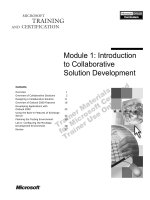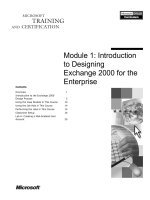Module 1 Introduction to Managing Microsoft Windows Server 2008 Environment doc
Bạn đang xem bản rút gọn của tài liệu. Xem và tải ngay bản đầy đủ của tài liệu tại đây (526.72 KB, 39 trang )
Module 1
Introduction to
Managing Microsoft®
Windows Server® 2008
Environment
Module Overview
•
Server Roles
•
Overview of Active Directory
•
Using Microsoft Windows Server 2008 Administrative Tools
•
Using Remote Desktop for Administration
Lesson 1: Server Roles
•
Windows Server 2008 Editions
•
What Are Server Roles?
•
What Are the Windows Infrastructure Services Roles?
•
What Are the Windows Application Platform Services Roles?
•
What Are the Active Directory Server Roles?
•
AD DS Integration with Other Active Directory Server Roles
•
What Are Server Features?
•
What Is Server Core?
Windows Server 2008 Editions
The Windows Server 2008 editions are:
•
Windows Web Server 2008
•
Windows Server 2008 Standard
•
Windows Server 2008 Standard without Hyper-V
•
Windows Server 2008 Enterprise
•
Windows Server 2008 Enterprise without Hyper-V
•
Windows Server 2008 Datacenter
•
Windows Server 2008 Datacenter without Hyper-V
•
Windows Server 2008 for Itanium-Based Systems
•
Windows HPC Server 2008
What Are Server Roles?
Server roles describe the primary server function
Server roles describe the primary server function
File Services
File Services
DNS Server
DNS Server
Active Directory
Domain Services
Active Directory
Domain Services
Print Services
Print Services
Web Server IIS
Web Server IIS
What Are the Windows Infrastructure Services Roles?
Windows Infrastructures Services roles include:
•
Active Directory Certificate Services
•
Active Directory Rights Management Services
•
DHCP Server
•
DNS Server
•
Fax Server
•
File Services
•
Hyper-V
•
Network Policy and Access Services
•
Print Services
•
Terminal Services
•
Windows Deployment Services
What Are the Windows Application Platform
Services Roles?
Windows Application Platform Services roles include:
•
Application Server
•
UDDI Services
•
Web Server (IIS)
What Are the Active Directory Server Roles?
Server Role Description
Active Directory
Domain Services
(AD DS)
A centralized directory for user and computer management
and authentication for a Windows Server 2008 network
Active Directory
Lightweight
Directory Services
(AD LDS)
An LDAP directory service that provides data storage and
retrieval support for directory-enabled applications, without
the requirement to deploy domains or domain controllers
Active Directory
Certificate Services
(AD CS)
A solution used to protect information stored in documents,
e-mail messages, and Web sites from unauthorized viewing,
modification, or use
Active Directory
Rights Management
Services (AD RMS)
An information-protection technology that works with AD
RMS-enabled applications to help safeguard digital
information from unauthorized use
Active Directory
Federation Services
(AD FS)
A server role in Windows Server 2008 that provides Web
SSO technologies to authenticate a user to multiple Web
applications over the life of a single online session
AD DS Integration with Other Active Directory
Server Roles
•
AD DS is the foundation for a
functional network
•
Most server roles depend on
AD DS to provide user and
resource information for the
other server roles
•
AD DS also provides
authentication and
authorization services
AD CS
AD RMS
AD FS
AD DS
What Are Server Features?
Server features are supporting services that can be installed
Server features are supporting services that can be installed
Examples of server features:
• .NET Framework 3.0
• BitLocker™ Drive Encryption
• Network Load Balancing
• Failover Clustering
• Desktop Experience
•
Windows PowerShell™
What Is Server Core?
A Server Core is an installation of Windows Server 2008
that:
•
Has minimal services
•
Has no graphical interface
•
Increases security
•
Can be configured in a limited number of roles
Lesson 2: Overview of Active Directory
•
What Is Active Directory?
•
Benefits of Active Directory
•
What Is a Domain?
•
What Is an Organizational Unit?
•
What Is a Forest?
•
What Is a Domain Controller?
•
What is a Read-Only Domain Controller?
•
Read-Only Domain Controller Features
What Is Active Directory?
Active Directory:
•
Is a central repository of network information
•
Is organized into domains, trees, and forests
•
Has multiple partitions:
–
Domain
–
Configuration
–
Schema
Benefits of Active Directory
Compared to a workgroup, the benefits of Active
Directory include:
•
Simplified security management
•
Redundant storage of security information
•
Group Policy
•
Extensibility
•
Delegation of administration
What Is a Domain?
A domain is a logical grouping of objects
such as computer and user accounts
A domain is a logical grouping of objects
such as computer and user accounts
Computer
accounts
User
accounts
What Is an Organizational Unit?
Computer
Account
User
Account
Organizational units in a domain
An OU is a
container within a
domain
An OU is a
container within a
domain
What Is a Forest?
eu.
nwtrader.
msft
nwtrader.
msft
na.
nwtrader.
msft
A forest is a
collection of
domains that
trust each other
A forest is a
collection of
domains that
trust each other
sales.
contoso.
msft
Tree
contoso.
msft
Global
Catalog
What Is a Domain Controller?
A domain controller:
•
Holds a copy of Active Directory
•
Responds to requests for Active Directory information
•
Authenticates users to the network
•
Is located by querying DNS
•
Takes part in multi-master replication throughout the domain
and forest
What Is a Read-Only Domain Controller?
RODCs host read-only partitions of the
AD DS database, only accept replicated
changes to Active Directory, and never
initiate replication
RODCs host read-only partitions of the
AD DS database, only accept replicated
changes to Active Directory, and never
initiate replication
RODCs:
•
Cannot hold operation master roles or be configured as replication
bridgehead servers
• Can be deployed on servers running Windows Server 2008 Server
core for additional security
RODCs provide:
• Additional security for branch office with limited physical security
•
Additional security if applications must run on a domain controller
RODC
RODC
Read-Only Domain Controller Features
RODCs provide:
• Unidirectional replication
•
Credential caching
•
Administrative role separation
• Read-only DNS
•
RODC filtered attribute set
Demonstration: Joining a Domain
In this demonstration, you will see how to:
•
Join a computer to a domain
Lesson 3: Using Windows Server 2008
Administrative Tools
•
Microsoft Management Console
•
Server Manager
•
Computer Management
•
Device Manager
•
Problem Reports and Solutions
•
Common Administration Tasks
Microsoft Management Console
The Microsoft Management Console (MMC):
• Is a framework for developing administrative
tools
• Uses snap-ins to provide functionality
•
Allows you to create custom consoles
The Microsoft Management Console (MMC):
• Is a framework for developing administrative
tools
• Uses snap-ins to provide functionality
•
Allows you to create custom consoles
Server Manager
•
Add or remove server roles
•
Add or remove server features
•
Monitor system events
•
Manage devices
•
Schedule tasks
•
Manage local users and groups
•
Configure Windows Firewall
•
Configure storage
• Perform a backup
Server Manager is an MMC console with several snap-ins
for managing your server
Server Manager is an MMC console with several snap-ins
for managing your server
Computer Management
Computer Management considerations:
•
Does not include roles and features
•
Includes many of the same snap-ins as Server
Manager
•
Can manage Routing and Remote Access
•
Can manage shared folders
•
Also included in previous version of Windows
Computer Management is an MMC console with several
snap-ins for managing your server
Computer Management is an MMC console with several
snap-ins for managing your server









